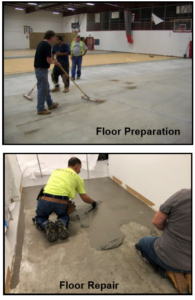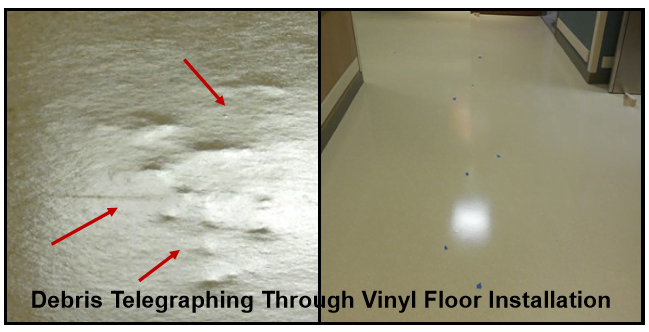WHAT IS STANDARD FLOOR PREP?
 The question, “What is standard floor prep?”, comes up when a general contractor has doubts when he is told the extent of the work that he expects to preform is beyond the scope of what “standard” means. The old standard for floor prep is to apply the flooring material (carpet, LVT, wood, etc.) to a clean concrete surface, which would include the removal of any contaminants, adhesive, dust, debris, curing compounds, etc.
The question, “What is standard floor prep?”, comes up when a general contractor has doubts when he is told the extent of the work that he expects to preform is beyond the scope of what “standard” means. The old standard for floor prep is to apply the flooring material (carpet, LVT, wood, etc.) to a clean concrete surface, which would include the removal of any contaminants, adhesive, dust, debris, curing compounds, etc.
This issue is important because so many installation failures are caused by substrate problems. However, the responsibility of the flooring dealer or contractor is not to repair the substrate, but to prep it for installation. Repairing requires work that is not part of the installation and most often is supposed to be done by someone other than floorcovering people, unless of course, it’s part of the flooring contract. That said, I’ll share with you part of my communication with this flooring dealer. Is prep leveling? No. Leveling is something else and requires more.
“I would love to see an article that defines floor prep to the general contractors of the world. When I say define, I mean the difference in prepare vs. repair. I view floor preparation exactly as it reads: preparing the substrate to receive flooring material. This includes patching minor holes and saw cuts, sanding, sweeping, and cleaning the substrate to ensure proper bonding of the material being installed. I view floor repair exactly as it reads: grinding, filling, topping, leveling etc. to qualify the substrate for floor covering. For whatever reason, we (flooring dealers, contractors and installers) are expected to repair and prepare and never blink an eye. I certainly agree that there is a certain amount of prep that goes with the install, as we will never walk into an installation and immediately start installing the product. However, if the substrate contractor does not properly do his job, how does it become the floor covering installer’s responsibility to prepare/repair?”
Floor prep means preparing the floor to receive flooring material. The amount of floor prep can vary depending on the material. Vinyl sheet goods require a more finished substrate than carpet installed over a cushion. Vinyl will telegraph every little irregularity in the floor.
Carpet over cushion will hide a multitude of sins beneath it. The amount of floor prep is dictated by the flooring material, the installation site, and the condition of the substrate. But, as our flooring dealer states, where do you draw the line? Flooring dealers, contractors, and installers are not substrate finish men. They aren’t supposed to, nor should they be required to, without compensation, put the substrate in a condition to receive the flooring material. Floor prep means what our dealer said, patching holes, doing some minor leveling, and general cleaning up to allow the flooring material to be installed. When the substrate requires major work involving overall leveling, grinding, etc., that’s where the game changes.
Floor prep should be simple and basic requirements employed daily, as a routine and a standard of care, to facilitate the installation of whatever flooring material is to be installed. Floor repair means a concerted and specific effort to repair a substrate that is not in a condition for installation without making major modifications. Let’s say it this way; prep is painting the walls with very little done to them other than filling nail holes and some dents – things the painter does. Repairing the walls would require patching large holes or replacing sections of dry wall; this is work for the drywall contractor. If the painter has to do it all, he gets paid for the extra work. It’s no different for the flooring guys.

The installation of any flooring material requires the subfloor or substrate onto which it is to be installed, receive some type of preparation before the installation takes place. That could be as simple as acclimating the space to the appropriate temperature prescribed by the flooring manufacturer, so the material is not shocked when it comes in contact with the substrate. But the question arises as to what amount of floor prep should be done, as part of the bid work for the installation, and what amount is extra that would not be considered part of the standard practice for installing the flooring material.
Minor prep work would be scraping the old adhesive off the floor so that it is smooth; no ridges, high spots or residue which would impede the application of new adhesive or prevent adhesion. Patching the substrate to even out rough spots, dips, depressions or anything that may telegraph through the new flooring, would be minor prep work as long as it just involved troweling on patch. Minor prep work would be a simple process that did not require extensive and involved processes or procedures; those things that would be considered part of a normal installation process. To make a comparison we can use the analogy of washing the car, drying it, and then applying a coat of wax to produce a clean shiny surface. One of our flooring contractors polled for this articles said, “we have had tremendous success when we quantify and clearly define what we have included as minor prep and quantify the man days, “Minor prep which includes 5 man days with appropriate material”
Major floor prep would involve a process that would require something other than a simple scraping of old adhesive and application of patch to specific spots. Major prep would involve mechanical scraping of old adhesive, applying a sealer to the old adhesive to prevent reaction, such as containing cut back. It could also be grinding the subsurface to remove old adhesives or bead blasting the substrate, applying a sealer and a top coat of cementitious material. Applying a leveling agent overall would be considered major prep as would leveling the substrate. Major prep could also be putting down a separate sealer for a minor moisture or porosity issue, which could be as simple as an application of latex or more involved with a specific moisture mitigation material. Major prep work would also include filling cracks, ramping up the substrate so that two different thicknesses of flooring material could meet evenly or treating large cracks with special fillers. It could also be applying a leveling agent over a ceramic floor to even grout lines so the new flooring would be level and not show any substrate inconsistencies. To make a comparison with the car again, this would be like sanding, filling, and preparing the car for new paint that will make it shiny and new; a lot more than just washing and waxing.
When you have to start making changes to the substrate to accommodate the installation of new flooring material that involves more than just a simple scraping and patching, you’re into major floor prep. This is work that should require an additional charge. Major floor prep is a completely separate aspect of the installation process. If a substrate is not conducive for receiving a new flooring material, especially one that requires near perfection, it will require whatever it takes to make sure nothing from beneath spoils the surface appearance of the new material and that means extra work.
Making the substrate acceptable to receive new flooring, depending on what that is, can be as simple and minor of an undertaking as scraping off old adhesive with razor scrapers, or as involved as refinishing or re-configuring the entire surface. One is minor and part of the normal installation process and fee and the other is major and a completely different undertaking for which there is a separate charge.
Standard floor prep or minor floor prep?
The industry uses the two terms interchangeably in many instances. Both terms can mean very different things to different parties on a construction project. While a general contractor would prefer minor or standard floor prep to include everything necessary to successfully install a floor covering short of warranty change orders, a flooring contractor sees the scope as far less encompassing. Generally, a flooring contractor would consider minor/standard floor prep as:
- Passing a floor sander over the surface to knock loose any superficial surface debris
- Passing a floor scraper over the surface for minimal removal of surface debris
- Sweeping and/or vacuuming to remove dust and surface debris, as applicable
- Spot patching or skimming to make minor transitions and fill low spots, occasional bird baths or smooth minimal cracks or divots
- While both flooring and general contractors will likely agree that removal of existing flooring, setting materials, major surface grinding to remove high spots, mechanical profiling, applying moisture control or self-leveling, constitute “major” preparation and typically become change order work; general contractors often like to include the following as standard work:
- Skimming of the entire concrete surface
- Removal of all paint overspray, dry wall mud, and other construction related contamination such as fire proofing materials, caulking, etc… on the concrete regardless of the quantity
- Dealing with topically applied curing compounds which will prevent issuance or enforcement of the flooring manufacturers’ warranty These items are not required as a condition of the floor installation, but only become necessary when conditions require they be addressed.
This is the gray area where there is likely to be a disagreement with regard to the scope of standard/minor vs. excessive prep work under the base contract. There can be a lot of variables as every job and every substrate is different. How was the job bid? How was the budget for the project and the flooring component developed? The General Contractor may put together a fair allowance for floor prep. The GC may ask for time and material basis for floor prep. How it was originally priced or what happens after the job gets started? Another consideration is that you can’t price what you can’t see in older buildings that are still intact. The fair expectation for floor prep is often a best guess and go from there. Furthermore, what do the manufacturers installation guidelines say you have to do to comply with their warranty? Hopefully, this will shed some light on floor prep so you can use it as a guideline on your projects. The most helpful advice that I would give you is to communicate. You have to talk to whoever it is that’s in charge of the project, develop a relationship with them, be a member of the team, and be a part of the process. If you have any questions, need help on a project from substrate to surfaces, or need some guidance, call us. We exist to help you. And don’t think your question is without merit. As I always say, if you don’t ask; you don’t get.
Article Courtesy of LGM and Associates